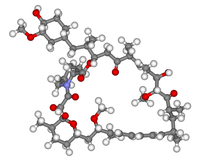
Photo from wikipedia
Previous studies have shown that simvastatin (Sim) has neuroprotective effects in a neonatal model of hypoxia-ischemia (HI)-induced brain injury when administered before but not after HI, pointing to the preconditioning… Click to show full abstract
Previous studies have shown that simvastatin (Sim) has neuroprotective effects in a neonatal model of hypoxia-ischemia (HI)-induced brain injury when administered before but not after HI, pointing to the preconditioning (PC)-like effects of the statin. The present study aimed to gain more insight into the PC-like effect of Sim by studying the role of autophagy and its modulation by mTOR and SIRT1 in neuroprotection. Sim potentiated the autophagy response induced by neonatal HI, as shown by the increased expression of both microtubule-associated protein 1 light chain 3 (LC3) and beclin 1, increased monodansylcadaverine (MDC) labeling, and reduced expression of p62. The autophagy inhibitor 3-methyladenine (3MA) completely blocked the neuroprotective effect of Sim. Two hours after HI, there was a reduction in the activity of mTORC1 and a concomitant increase in that of mTORC2. Sim preconditioning further decreased the activity of mTORC1, but did not affect that of mTORC2. However, 24 h after injury, mTORC2 activity was significantly preserved in Sim-treated rats. Sim preconditioning also prevented the depletion of SIRT1 induced by HI, an effect that was completely blocked by 3MA. These data show that Sim preconditioning may modulate autophagy and survival pathways by affecting mTORC1, mTORC2, and SIRT1 activities. This study provides further preclinical evidence of the PC-like effect of statins in brain tissue, supporting their beneficial effects in improving stroke outcome after prophylactic treatments.
Journal Title: Experimental Neurology
Year Published: 2020
Link to full text (if available)
Share on Social Media: Sign Up to like & get
recommendations!